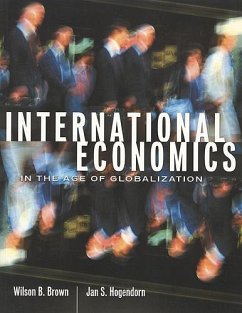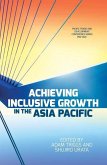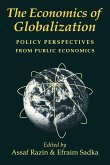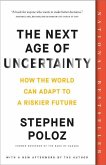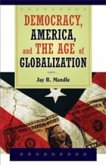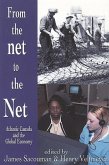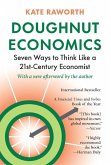- Broschiertes Buch
- Merkliste
- Auf die Merkliste
- Bewerten Bewerten
- Teilen
- Produkt teilen
- Produkterinnerung
- Produkterinnerung
International Economics in the Age of Globalization provides the intellectual basis for an understanding of the increasingly integrated world economy. The requisite background is not solely economic theory, but includes the history and the purposes and workings of the organizations, laws, instruments, and customary practices in the international economy. Economic theory is not limited to the abstract; its concern with institutions has both a practical and theoretical base. How can one evaluate a criticism of the World Trade Organization, a fear of the dangers of financial derivatives, the…mehr
Andere Kunden interessierten sich auch für
![Achieving Inclusive Growth in the Asia Pacific Achieving Inclusive Growth in the Asia Pacific]() Achieving Inclusive Growth in the Asia Pacific41,99 €
Achieving Inclusive Growth in the Asia Pacific41,99 €![The Economics of Globalization The Economics of Globalization]() The Economics of Globalization60,99 €
The Economics of Globalization60,99 €![The Next Age of Uncertainty The Next Age of Uncertainty]() Stephen PolozThe Next Age of Uncertainty15,99 €
Stephen PolozThe Next Age of Uncertainty15,99 €![Democracy, America, and the Age of Globalization Democracy, America, and the Age of Globalization]() Jay R MandleDemocracy, America, and the Age of Globalization30,99 €
Jay R MandleDemocracy, America, and the Age of Globalization30,99 €![Identity Politics in the Age of Genocide Identity Politics in the Age of Genocide]() David B MacDonaldIdentity Politics in the Age of Genocide57,99 €
David B MacDonaldIdentity Politics in the Age of Genocide57,99 €![From the Net to the Net From the Net to the Net]() From the Net to the Net40,99 €
From the Net to the Net40,99 €![Doughnut Economics Doughnut Economics]() Kate RaworthDoughnut Economics18,99 €
Kate RaworthDoughnut Economics18,99 €-
-
-
International Economics in the Age of Globalization provides the intellectual basis for an understanding of the increasingly integrated world economy. The requisite background is not solely economic theory, but includes the history and the purposes and workings of the organizations, laws, instruments, and customary practices in the international economy. Economic theory is not limited to the abstract; its concern with institutions has both a practical and theoretical base. How can one evaluate a criticism of the World Trade Organization, a fear of the dangers of financial derivatives, the supposed freedom of a multinational firm, or the presumed unfairness of dumping without knowing both theory and institutions? Where did these institutions come from? What problems are they solving—as well as creating? This book's balance between theory and institutions is akin to texts in Public Expenditure or Money and Banking. The leading international economics texts, in contrast, push the real world into the background and present the subject as a more specialized intermediate theory course, accessible only to people who have a solid theoretical background. The result is that good discussions of many of the key issues in modern international economics simply are not available in the curriculum, or accessible to any but economics majors. This book aims to remedy that failing, challenging economics majors and non-majors alike. It will also be of value to students of business and public affairs and to the economic-literate general public.
Produktdetails
- Produktdetails
- Verlag: University of Toronto Press
- Seitenzahl: 792
- Erscheinungstermin: 1. Mai 2000
- Englisch
- Abmessung: 229mm x 178mm x 40mm
- Gewicht: 1365g
- ISBN-13: 9781551112619
- ISBN-10: 1551112612
- Artikelnr.: 40558898
- Herstellerkennzeichnung
- Libri GmbH
- Europaallee 1
- 36244 Bad Hersfeld
- gpsr@libri.de
- Verlag: University of Toronto Press
- Seitenzahl: 792
- Erscheinungstermin: 1. Mai 2000
- Englisch
- Abmessung: 229mm x 178mm x 40mm
- Gewicht: 1365g
- ISBN-13: 9781551112619
- ISBN-10: 1551112612
- Artikelnr.: 40558898
- Herstellerkennzeichnung
- Libri GmbH
- Europaallee 1
- 36244 Bad Hersfeld
- gpsr@libri.de
Written by Wilson B. Brown and Jan S. Hogendorn
1. The Nature of International Economics
Globalization
International Economics in Daily Life
The Growth of Economic Interdependence
Statistics with Some Grains of Salt
Looking Forward
Vocabulary and Concepts / Questions
Notes
> Part I: International Trade
2. The Theory of Comparative Advantage
The Gains from Trade in General Equilibrium
The Gains from Trade in Partial Equilibrium
Relaxing the Assumptions
Conclusion
Appendix: Offer Curves
Vocabulary and Concepts / Questions
Notes
3. The Sources of Comparative Advantage
Factor Proportions: The Heckscher-Olin Model
Two Challenges to the Heckscher-Olin Model
Why Trade Arises among Similar Countries
Segmented Markets as an Explanation for Trade
What Could Trigger the Direction of Specialization?
Dislocation and Intraindustrial Trade
Conclusion
Vocabulary and Concepts / Questions
Notes
4. Tariffs, Quotas, and VERs
Tariffs
Analysis of Tariffs: Their Effects
Quotas and Their Economic Effects
Voluntary Export Restraints
Appendix: The Terms-of-Trade Effect in General Equilibrium
Vocabulary and Concepts / Questions
Notes
5. The Face of Modern Protectionism
Subsidy and Tax Issues
Administrative Protection
Technical, Health, Safety, and Environmental Standards
How Can Distortions To Trade Be Compared?
Playing the Protectionist Instruments
Conclusion
Vocabulary and Concepts / Questions
Notes
6. The Political Economy of Trade Barriers
A Short History of Trade Policy
The Uruguay Round and the World Trade Organization
Why Do Countries Persist in Protectionism?
The Arguments for Trade Barriers
Conclusion
Vocabulary and Concepts / Questions
Notes
7. Unfair Trade Practices
Dumping
Subsidies
Other Unfair Trade Practices
Conclusion
Vocabulary and Concepts / Questions
Notes
8. National Trade Policies
Managed Trade
Strategic Trade Policy
Japanese Use of a National Trade Strategy
Adjusting to Trade as a National Strategy
Trade Sanctions
Vocabulary and Concepts / Questions
Notes
9. Economic Integration
The Types of Economic Integration
The Great Debate: Trade Creation or Trade Diversion
Dynamic Effects of Economic Integration
A Checklist of Conditions for Welfare Improvement
The Major Examples of Economic Integration
Very Large PTAs
PTAs with a Rich Patron
Regional Trade Arrangements in the LDCs
Foreign Trade Zones: Little Bits of Free Trade
Conclusion
Vocabulary and Concepts / Questions
Notes
Part II: International Macroeconomics: Saving, Growth, and Finance
10. Saving, Investment, and the Trade Balance
How Can Countries Have Trade Imbalances?
The Three Real Imbalances: Imports-Exports, Saving-Investment, and
Output-Absorption
Financial Markets: Borrowing and Lending
Trade Imbalances as Problems and Symptoms
Total Investment Equals Total Savings
The International Capital Market and National Saving
Government Savings and Trade Deficits: The Twin Deficit Question
Private Saving
Conclusion
Appendix: Where to Find the Numbers
Vocabulary and Concepts / Questions
Notes
11. The Balance of Payments
Why Study the Balance of Payments?
What a Balance-of-Payments Statement Shows
Balance-of-Payments Accounting
The Structure of the Balance of Payments
Using Balance-of-Payments Statements as Analytical Tools
The World Deficit
Conclusion
Vocabulary and Concepts / Questions
Notes
12. Income and Price Effects
Income and Price Changes
Income Effects
Some International Implications
Price and Income: Two Intriguing Cases
Conclusion
Vocabulary and Concepts / Questions
Notes
13. Interest Rates, Prices, and Foreign Exchange
The Foreign Exchange Market
The Vast Sums Traded
Interest Rate Parity
The Longer Run: Price Levels and Purchasing Power Parity
International and Domestic Financial Markets
Conclusion
Vocabulary and Concepts / Questions
Notes
14. Money in the Global Economy
Three Ways of Looking at Money's Relation to Real Output
Modeling the Effects of Money Supply
Markets for Funds and Markets for Liquidity
Monetary Policy
National Money Supplies and Global Flows
The Role of Money in Correcting Serious Balance-of-Payments Difficulties
The Problem of Large Capital Flows
Monetary and Fiscal Policy Together
Conclusion
Vocabulary and Concepts / Questions
Notes
15. Exchange Rate Adjustment
What Countries Really Do
The Role of the Exchange Rate in Adjusting to Payments Difficulties
Exchange Control
The Once-and-for-all Devaluation after Great Inflation
Revaluation (Upward Valuation)
Price Sensitivity: What Happens When Price Effects Work Slowly
Exchange Rate Changes and the EXIN Model
Conclusion
Vocabulary and Concepts / Questions
Notes
16. International Financial Markets
The Functions of Financial Markets
The Advantages of Large Markets
An Overview of the International Markets
Eurodollars, T-accounts, and Monetary Expansion
Derivative and Swap Markets
Continuing Changes in the International Capital Market
Implications of the Changes
Conclusion
Vocabulary and Concepts / Questions
Notes
17. International Monetary Institutions (I)
The International System under the Gold Standard
The 1920s: Pegged Exchange Rates
The Great Depression
The Bretton Woods System: 1947-1973
Reserve Currencies
Special Drawing Rights
Borrowing Swap Lines
The End of the Bretton Woods System
The Bretton Woods System: An Assesment
Vocabulary and Concepts / Questions
Notes
18. International Monetary Institutions (II)
The Oil Crises
Floating Exchange Rates
The Debt Crisis
Currencies and Governments: How Many Currencies?
Deja Vu All Over Again
Vocabulary and Concepts / Questions
Notes
19. Multinational Firms, Foreign Direct Investment, and Globalization
Foreign Direct Investment and the Multinational Firm
FDI in Recent Years
The Theory of Foreign Direct Investment
Possible Reasons for the Recent Increase in FDI
Extent of the Firm's Freedom from Market Constraints
Issues MNFs Raise
Conclusion
Vocabulary and Concepts / Questions
Notes
Index
Globalization
International Economics in Daily Life
The Growth of Economic Interdependence
Statistics with Some Grains of Salt
Looking Forward
Vocabulary and Concepts / Questions
Notes
> Part I: International Trade
2. The Theory of Comparative Advantage
The Gains from Trade in General Equilibrium
The Gains from Trade in Partial Equilibrium
Relaxing the Assumptions
Conclusion
Appendix: Offer Curves
Vocabulary and Concepts / Questions
Notes
3. The Sources of Comparative Advantage
Factor Proportions: The Heckscher-Olin Model
Two Challenges to the Heckscher-Olin Model
Why Trade Arises among Similar Countries
Segmented Markets as an Explanation for Trade
What Could Trigger the Direction of Specialization?
Dislocation and Intraindustrial Trade
Conclusion
Vocabulary and Concepts / Questions
Notes
4. Tariffs, Quotas, and VERs
Tariffs
Analysis of Tariffs: Their Effects
Quotas and Their Economic Effects
Voluntary Export Restraints
Appendix: The Terms-of-Trade Effect in General Equilibrium
Vocabulary and Concepts / Questions
Notes
5. The Face of Modern Protectionism
Subsidy and Tax Issues
Administrative Protection
Technical, Health, Safety, and Environmental Standards
How Can Distortions To Trade Be Compared?
Playing the Protectionist Instruments
Conclusion
Vocabulary and Concepts / Questions
Notes
6. The Political Economy of Trade Barriers
A Short History of Trade Policy
The Uruguay Round and the World Trade Organization
Why Do Countries Persist in Protectionism?
The Arguments for Trade Barriers
Conclusion
Vocabulary and Concepts / Questions
Notes
7. Unfair Trade Practices
Dumping
Subsidies
Other Unfair Trade Practices
Conclusion
Vocabulary and Concepts / Questions
Notes
8. National Trade Policies
Managed Trade
Strategic Trade Policy
Japanese Use of a National Trade Strategy
Adjusting to Trade as a National Strategy
Trade Sanctions
Vocabulary and Concepts / Questions
Notes
9. Economic Integration
The Types of Economic Integration
The Great Debate: Trade Creation or Trade Diversion
Dynamic Effects of Economic Integration
A Checklist of Conditions for Welfare Improvement
The Major Examples of Economic Integration
Very Large PTAs
PTAs with a Rich Patron
Regional Trade Arrangements in the LDCs
Foreign Trade Zones: Little Bits of Free Trade
Conclusion
Vocabulary and Concepts / Questions
Notes
Part II: International Macroeconomics: Saving, Growth, and Finance
10. Saving, Investment, and the Trade Balance
How Can Countries Have Trade Imbalances?
The Three Real Imbalances: Imports-Exports, Saving-Investment, and
Output-Absorption
Financial Markets: Borrowing and Lending
Trade Imbalances as Problems and Symptoms
Total Investment Equals Total Savings
The International Capital Market and National Saving
Government Savings and Trade Deficits: The Twin Deficit Question
Private Saving
Conclusion
Appendix: Where to Find the Numbers
Vocabulary and Concepts / Questions
Notes
11. The Balance of Payments
Why Study the Balance of Payments?
What a Balance-of-Payments Statement Shows
Balance-of-Payments Accounting
The Structure of the Balance of Payments
Using Balance-of-Payments Statements as Analytical Tools
The World Deficit
Conclusion
Vocabulary and Concepts / Questions
Notes
12. Income and Price Effects
Income and Price Changes
Income Effects
Some International Implications
Price and Income: Two Intriguing Cases
Conclusion
Vocabulary and Concepts / Questions
Notes
13. Interest Rates, Prices, and Foreign Exchange
The Foreign Exchange Market
The Vast Sums Traded
Interest Rate Parity
The Longer Run: Price Levels and Purchasing Power Parity
International and Domestic Financial Markets
Conclusion
Vocabulary and Concepts / Questions
Notes
14. Money in the Global Economy
Three Ways of Looking at Money's Relation to Real Output
Modeling the Effects of Money Supply
Markets for Funds and Markets for Liquidity
Monetary Policy
National Money Supplies and Global Flows
The Role of Money in Correcting Serious Balance-of-Payments Difficulties
The Problem of Large Capital Flows
Monetary and Fiscal Policy Together
Conclusion
Vocabulary and Concepts / Questions
Notes
15. Exchange Rate Adjustment
What Countries Really Do
The Role of the Exchange Rate in Adjusting to Payments Difficulties
Exchange Control
The Once-and-for-all Devaluation after Great Inflation
Revaluation (Upward Valuation)
Price Sensitivity: What Happens When Price Effects Work Slowly
Exchange Rate Changes and the EXIN Model
Conclusion
Vocabulary and Concepts / Questions
Notes
16. International Financial Markets
The Functions of Financial Markets
The Advantages of Large Markets
An Overview of the International Markets
Eurodollars, T-accounts, and Monetary Expansion
Derivative and Swap Markets
Continuing Changes in the International Capital Market
Implications of the Changes
Conclusion
Vocabulary and Concepts / Questions
Notes
17. International Monetary Institutions (I)
The International System under the Gold Standard
The 1920s: Pegged Exchange Rates
The Great Depression
The Bretton Woods System: 1947-1973
Reserve Currencies
Special Drawing Rights
Borrowing Swap Lines
The End of the Bretton Woods System
The Bretton Woods System: An Assesment
Vocabulary and Concepts / Questions
Notes
18. International Monetary Institutions (II)
The Oil Crises
Floating Exchange Rates
The Debt Crisis
Currencies and Governments: How Many Currencies?
Deja Vu All Over Again
Vocabulary and Concepts / Questions
Notes
19. Multinational Firms, Foreign Direct Investment, and Globalization
Foreign Direct Investment and the Multinational Firm
FDI in Recent Years
The Theory of Foreign Direct Investment
Possible Reasons for the Recent Increase in FDI
Extent of the Firm's Freedom from Market Constraints
Issues MNFs Raise
Conclusion
Vocabulary and Concepts / Questions
Notes
Index
1. The Nature of International Economics
Globalization
International Economics in Daily Life
The Growth of Economic Interdependence
Statistics with Some Grains of Salt
Looking Forward
Vocabulary and Concepts / Questions
Notes
> Part I: International Trade
2. The Theory of Comparative Advantage
The Gains from Trade in General Equilibrium
The Gains from Trade in Partial Equilibrium
Relaxing the Assumptions
Conclusion
Appendix: Offer Curves
Vocabulary and Concepts / Questions
Notes
3. The Sources of Comparative Advantage
Factor Proportions: The Heckscher-Olin Model
Two Challenges to the Heckscher-Olin Model
Why Trade Arises among Similar Countries
Segmented Markets as an Explanation for Trade
What Could Trigger the Direction of Specialization?
Dislocation and Intraindustrial Trade
Conclusion
Vocabulary and Concepts / Questions
Notes
4. Tariffs, Quotas, and VERs
Tariffs
Analysis of Tariffs: Their Effects
Quotas and Their Economic Effects
Voluntary Export Restraints
Appendix: The Terms-of-Trade Effect in General Equilibrium
Vocabulary and Concepts / Questions
Notes
5. The Face of Modern Protectionism
Subsidy and Tax Issues
Administrative Protection
Technical, Health, Safety, and Environmental Standards
How Can Distortions To Trade Be Compared?
Playing the Protectionist Instruments
Conclusion
Vocabulary and Concepts / Questions
Notes
6. The Political Economy of Trade Barriers
A Short History of Trade Policy
The Uruguay Round and the World Trade Organization
Why Do Countries Persist in Protectionism?
The Arguments for Trade Barriers
Conclusion
Vocabulary and Concepts / Questions
Notes
7. Unfair Trade Practices
Dumping
Subsidies
Other Unfair Trade Practices
Conclusion
Vocabulary and Concepts / Questions
Notes
8. National Trade Policies
Managed Trade
Strategic Trade Policy
Japanese Use of a National Trade Strategy
Adjusting to Trade as a National Strategy
Trade Sanctions
Vocabulary and Concepts / Questions
Notes
9. Economic Integration
The Types of Economic Integration
The Great Debate: Trade Creation or Trade Diversion
Dynamic Effects of Economic Integration
A Checklist of Conditions for Welfare Improvement
The Major Examples of Economic Integration
Very Large PTAs
PTAs with a Rich Patron
Regional Trade Arrangements in the LDCs
Foreign Trade Zones: Little Bits of Free Trade
Conclusion
Vocabulary and Concepts / Questions
Notes
Part II: International Macroeconomics: Saving, Growth, and Finance
10. Saving, Investment, and the Trade Balance
How Can Countries Have Trade Imbalances?
The Three Real Imbalances: Imports-Exports, Saving-Investment, and
Output-Absorption
Financial Markets: Borrowing and Lending
Trade Imbalances as Problems and Symptoms
Total Investment Equals Total Savings
The International Capital Market and National Saving
Government Savings and Trade Deficits: The Twin Deficit Question
Private Saving
Conclusion
Appendix: Where to Find the Numbers
Vocabulary and Concepts / Questions
Notes
11. The Balance of Payments
Why Study the Balance of Payments?
What a Balance-of-Payments Statement Shows
Balance-of-Payments Accounting
The Structure of the Balance of Payments
Using Balance-of-Payments Statements as Analytical Tools
The World Deficit
Conclusion
Vocabulary and Concepts / Questions
Notes
12. Income and Price Effects
Income and Price Changes
Income Effects
Some International Implications
Price and Income: Two Intriguing Cases
Conclusion
Vocabulary and Concepts / Questions
Notes
13. Interest Rates, Prices, and Foreign Exchange
The Foreign Exchange Market
The Vast Sums Traded
Interest Rate Parity
The Longer Run: Price Levels and Purchasing Power Parity
International and Domestic Financial Markets
Conclusion
Vocabulary and Concepts / Questions
Notes
14. Money in the Global Economy
Three Ways of Looking at Money's Relation to Real Output
Modeling the Effects of Money Supply
Markets for Funds and Markets for Liquidity
Monetary Policy
National Money Supplies and Global Flows
The Role of Money in Correcting Serious Balance-of-Payments Difficulties
The Problem of Large Capital Flows
Monetary and Fiscal Policy Together
Conclusion
Vocabulary and Concepts / Questions
Notes
15. Exchange Rate Adjustment
What Countries Really Do
The Role of the Exchange Rate in Adjusting to Payments Difficulties
Exchange Control
The Once-and-for-all Devaluation after Great Inflation
Revaluation (Upward Valuation)
Price Sensitivity: What Happens When Price Effects Work Slowly
Exchange Rate Changes and the EXIN Model
Conclusion
Vocabulary and Concepts / Questions
Notes
16. International Financial Markets
The Functions of Financial Markets
The Advantages of Large Markets
An Overview of the International Markets
Eurodollars, T-accounts, and Monetary Expansion
Derivative and Swap Markets
Continuing Changes in the International Capital Market
Implications of the Changes
Conclusion
Vocabulary and Concepts / Questions
Notes
17. International Monetary Institutions (I)
The International System under the Gold Standard
The 1920s: Pegged Exchange Rates
The Great Depression
The Bretton Woods System: 1947-1973
Reserve Currencies
Special Drawing Rights
Borrowing Swap Lines
The End of the Bretton Woods System
The Bretton Woods System: An Assesment
Vocabulary and Concepts / Questions
Notes
18. International Monetary Institutions (II)
The Oil Crises
Floating Exchange Rates
The Debt Crisis
Currencies and Governments: How Many Currencies?
Deja Vu All Over Again
Vocabulary and Concepts / Questions
Notes
19. Multinational Firms, Foreign Direct Investment, and Globalization
Foreign Direct Investment and the Multinational Firm
FDI in Recent Years
The Theory of Foreign Direct Investment
Possible Reasons for the Recent Increase in FDI
Extent of the Firm's Freedom from Market Constraints
Issues MNFs Raise
Conclusion
Vocabulary and Concepts / Questions
Notes
Index
Globalization
International Economics in Daily Life
The Growth of Economic Interdependence
Statistics with Some Grains of Salt
Looking Forward
Vocabulary and Concepts / Questions
Notes
> Part I: International Trade
2. The Theory of Comparative Advantage
The Gains from Trade in General Equilibrium
The Gains from Trade in Partial Equilibrium
Relaxing the Assumptions
Conclusion
Appendix: Offer Curves
Vocabulary and Concepts / Questions
Notes
3. The Sources of Comparative Advantage
Factor Proportions: The Heckscher-Olin Model
Two Challenges to the Heckscher-Olin Model
Why Trade Arises among Similar Countries
Segmented Markets as an Explanation for Trade
What Could Trigger the Direction of Specialization?
Dislocation and Intraindustrial Trade
Conclusion
Vocabulary and Concepts / Questions
Notes
4. Tariffs, Quotas, and VERs
Tariffs
Analysis of Tariffs: Their Effects
Quotas and Their Economic Effects
Voluntary Export Restraints
Appendix: The Terms-of-Trade Effect in General Equilibrium
Vocabulary and Concepts / Questions
Notes
5. The Face of Modern Protectionism
Subsidy and Tax Issues
Administrative Protection
Technical, Health, Safety, and Environmental Standards
How Can Distortions To Trade Be Compared?
Playing the Protectionist Instruments
Conclusion
Vocabulary and Concepts / Questions
Notes
6. The Political Economy of Trade Barriers
A Short History of Trade Policy
The Uruguay Round and the World Trade Organization
Why Do Countries Persist in Protectionism?
The Arguments for Trade Barriers
Conclusion
Vocabulary and Concepts / Questions
Notes
7. Unfair Trade Practices
Dumping
Subsidies
Other Unfair Trade Practices
Conclusion
Vocabulary and Concepts / Questions
Notes
8. National Trade Policies
Managed Trade
Strategic Trade Policy
Japanese Use of a National Trade Strategy
Adjusting to Trade as a National Strategy
Trade Sanctions
Vocabulary and Concepts / Questions
Notes
9. Economic Integration
The Types of Economic Integration
The Great Debate: Trade Creation or Trade Diversion
Dynamic Effects of Economic Integration
A Checklist of Conditions for Welfare Improvement
The Major Examples of Economic Integration
Very Large PTAs
PTAs with a Rich Patron
Regional Trade Arrangements in the LDCs
Foreign Trade Zones: Little Bits of Free Trade
Conclusion
Vocabulary and Concepts / Questions
Notes
Part II: International Macroeconomics: Saving, Growth, and Finance
10. Saving, Investment, and the Trade Balance
How Can Countries Have Trade Imbalances?
The Three Real Imbalances: Imports-Exports, Saving-Investment, and
Output-Absorption
Financial Markets: Borrowing and Lending
Trade Imbalances as Problems and Symptoms
Total Investment Equals Total Savings
The International Capital Market and National Saving
Government Savings and Trade Deficits: The Twin Deficit Question
Private Saving
Conclusion
Appendix: Where to Find the Numbers
Vocabulary and Concepts / Questions
Notes
11. The Balance of Payments
Why Study the Balance of Payments?
What a Balance-of-Payments Statement Shows
Balance-of-Payments Accounting
The Structure of the Balance of Payments
Using Balance-of-Payments Statements as Analytical Tools
The World Deficit
Conclusion
Vocabulary and Concepts / Questions
Notes
12. Income and Price Effects
Income and Price Changes
Income Effects
Some International Implications
Price and Income: Two Intriguing Cases
Conclusion
Vocabulary and Concepts / Questions
Notes
13. Interest Rates, Prices, and Foreign Exchange
The Foreign Exchange Market
The Vast Sums Traded
Interest Rate Parity
The Longer Run: Price Levels and Purchasing Power Parity
International and Domestic Financial Markets
Conclusion
Vocabulary and Concepts / Questions
Notes
14. Money in the Global Economy
Three Ways of Looking at Money's Relation to Real Output
Modeling the Effects of Money Supply
Markets for Funds and Markets for Liquidity
Monetary Policy
National Money Supplies and Global Flows
The Role of Money in Correcting Serious Balance-of-Payments Difficulties
The Problem of Large Capital Flows
Monetary and Fiscal Policy Together
Conclusion
Vocabulary and Concepts / Questions
Notes
15. Exchange Rate Adjustment
What Countries Really Do
The Role of the Exchange Rate in Adjusting to Payments Difficulties
Exchange Control
The Once-and-for-all Devaluation after Great Inflation
Revaluation (Upward Valuation)
Price Sensitivity: What Happens When Price Effects Work Slowly
Exchange Rate Changes and the EXIN Model
Conclusion
Vocabulary and Concepts / Questions
Notes
16. International Financial Markets
The Functions of Financial Markets
The Advantages of Large Markets
An Overview of the International Markets
Eurodollars, T-accounts, and Monetary Expansion
Derivative and Swap Markets
Continuing Changes in the International Capital Market
Implications of the Changes
Conclusion
Vocabulary and Concepts / Questions
Notes
17. International Monetary Institutions (I)
The International System under the Gold Standard
The 1920s: Pegged Exchange Rates
The Great Depression
The Bretton Woods System: 1947-1973
Reserve Currencies
Special Drawing Rights
Borrowing Swap Lines
The End of the Bretton Woods System
The Bretton Woods System: An Assesment
Vocabulary and Concepts / Questions
Notes
18. International Monetary Institutions (II)
The Oil Crises
Floating Exchange Rates
The Debt Crisis
Currencies and Governments: How Many Currencies?
Deja Vu All Over Again
Vocabulary and Concepts / Questions
Notes
19. Multinational Firms, Foreign Direct Investment, and Globalization
Foreign Direct Investment and the Multinational Firm
FDI in Recent Years
The Theory of Foreign Direct Investment
Possible Reasons for the Recent Increase in FDI
Extent of the Firm's Freedom from Market Constraints
Issues MNFs Raise
Conclusion
Vocabulary and Concepts / Questions
Notes
Index

